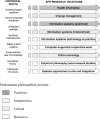Tensions and paradoxes in electronic patient record research: a systematic literature review using the meta-narrative method
- PMID: 20021585
- PMCID: PMC2888022
- DOI: 10.1111/j.1468-0009.2009.00578.x
Tensions and paradoxes in electronic patient record research: a systematic literature review using the meta-narrative method
Abstract
Context: The extensive research literature on electronic patient records (EPRs) presents challenges to systematic reviewers because it covers multiple research traditions with different underlying philosophical assumptions and methodological approaches.
Methods: Using the meta-narrative method and searching beyond the Medline-indexed literature, this review used "conflicting" findings to address higher-order questions about how researchers had differently conceptualized and studied the EPR and its implementation.
Findings: Twenty-four previous systematic reviews and ninety-four further primary studies were considered. Key tensions in the literature centered on (1) the EPR ("container" or "itinerary"); (2) the EPR user ("information-processer" or "member of socio-technical network"); (3) organizational context ("the setting within which the EPR is implemented" or "the EPR-in-use"); (4) clinical work ("decision making" or "situated practice"); (5) the process of change ("the logic of determinism" or "the logic of opposition"); (6) implementation success ("objectively defined" or "socially negotiated"); and (7) complexity and scale ("the bigger the better" or "small is beautiful").
Conclusions: The findings suggest that EPR use will always require human input to recontextualize knowledge; that even though secondary work (audit, research, billing) may be made more efficient by the EPR, primary clinical work may be made less efficient; that paper may offer a unique degree of ecological flexibility; and that smaller EPR systems may sometimes be more efficient and effective than larger ones. We suggest an agenda for further research.
Figures


References
-
- Aarts J, Ash J, Berg M. Extending the Understanding of Computerized Physician Order Entry: Implications for Professional Collaboration, Workflow and Quality of Care. International Journal of Medical Informatics. 2007;76(suppl. 1):S4–S13. - PubMed
-
- Aarts J, Berg M. A Tale of Two Hospitals: A Sociotechnical Appraisal of the Introduction of Computerized Physician Order Entry in Two Dutch Hospitals. Medinfo. 2004;11:999–1002. - PubMed
-
- Ackerman MS. The Intellectual Challenge of CSCW: The Gap between Social Requirements and Technical Feasibility. Human-Computer Interaction. 2000;15(2/3):179–203.
-
- Aderibigbe A, Brooks L, McGrath K. Electronic Patient Records and Nurses’ Work: Rhetoric and Reality. Paper presented at fifth Critical Management Studies conference; Manchester Business School; 2007. July 11–13, 2007, Manchester. Available at http://www.mngt.waikato.ac.nz/ejrot/cmsconference/2007/proceedings/criti...accessed September 29, 2009.
Publication types
MeSH terms
Grants and funding
LinkOut - more resources
Full Text Sources
Other Literature Sources
Miscellaneous

